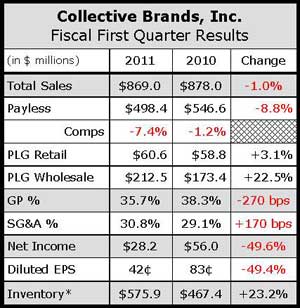Led by Saucony and Sperry Top-Sider, the Collective Brands Performance + Lifestyle Group (PLG) Wholesale segment delivered strong increases in sales and operating profit in the first quarter.
But Collective’s overall earnings fell due to weak North American retail sales at Payless as well as higher product costs. Net earnings tumbled 51.3 percent to $26.4 million, or 42 cents per share, far short of Wall Street’s consensus estimate of 82 cents. Revenues eased 1.1 percent to $869 million.

PLG Wholesale’s sales climbed 22.5 percent to $212.5 million. Sales grew both domestically and internationally with global gains in all four brands, led by strong double-digit gains in Sperry and Saucony. Operating earnings in the segment improved 8.6 percent to $25.3 million although operating margins eroded to 11.9 percent from 13.4 percent due to higher product costs and a less favorable channel mix. Based on backlogs being up 39 percent currently, PLG Wholesale’s sales in the second quarter are projected to increase 20 percent.
On a conference call with analysts, Matt Rubel, chairman, CEO, and president, said Sperry’s women’s business nearly doubled and sales were near parity to the men’s business due to its growing acceptance as a year-round, lifestyle brand. The brand is also finding faster growth at key premium and better department and specialty store channels and a good response from younger consumers.
Saucony saw growth across all geographic regions in both technical and athletic running product. Said Rubel, “The Saucony brand is gaining doors and shelf space in existing doors in the important and growing sporting goods channel. Our strength in minimalism continues, leveraging the overwhelming success of the Hattori. Were platforming minimalism into new models with both the Mirage and the Hattori off to great starts.”
Saucony is also expected to benefit from the opening of a performance lab to drive innovation as well as the launch of its Find Your Strong marketing campaign.
Keds high-single-digit revenue gain in the quarter was driven primarily by the Champion silhouette. Growth for Keds is coming in all selling channels, including pinnacle and premium accounts. Stride Rite’s near double-digit percentage gain was helped by strong sales of baby and toddler. Strong sales in kids were also seen in Sperry, Saucony and Jessica Simpson.
At the Payless Domestic segment, sales slid 8.8 percent to $498.4 million as same-store sales decreased 8.3 percent. Unseasonably cold and wet weather in the northern tier of North America particularly impacted traffic. “Easter came so late preceded by such unseasonable weather that the consumer did not engage in her typical buying patterns,” said Rubel.
Payless was also hampered by the impact of continued high unemployment and rising gas and food prices on the chain’s target customers, particularly African-Americans and Hispanics. Conversion was also lower as the consumer responded unfavorably to higher footwear prices, due to rising input costs. Customer traffic was down a low-double-digit percentage while average selling prices on domestic footwear were up 9 percent.
From a category perspective, the sales declines were primarily in sandals and children’s, offset in part by gains in fitness and women’s casuals.
Operating profits at Payless Domestic tumbled 73.6 percent to $13.0 million, reflecting the sales decline and higher product costs. Operating margins eroded to 2.6 percent from 9.0 percent a year ago.
Rubel said Payless plans to increase its promotional activity and messaging in a bid to “present sharper prices and greater discernible value” to its customer. Said Rubel, “While price increases are inevitable, we intend to modulate them based upon segment price elasticity and the white space available to us within each relevant competitive set.”
On a brighter side, consumers are responding to trends in the casual space, including cork wedges and espadrilles, floral designs, minimalist running, colored bottom athletic shoes, and boat shoes.
“While it’s still very early, we are encouraged by the favorable trends were seeing thus far in sales and traffic in the second quarter in a more normalized time period,” said Rubel.
Payless International’s revenues dipped 2.5 percent to $97.5 million, or down 5.1 percent on a comp basis. Significant comp gains in Latin America and 25 net new stores were offset by a sales decline in Canada, due to unseasonably cold and wet weather. Operating profits improved 8.6 percent to $25.3 million. Operating margins slid to 3.1 percent from 7.1 percent.
PLG Retail segment revenues increased 3.1 percent to $60.6 million as comps declined 2.8 percent. Sales growth from new Sperry stores and the Macy’s store-in-store channel more than offset declines at comparable Stride Rite Children’s locations. Due primarily to higher product costs, operating earnings slipped to $1.1 million from $1.9 million while operating margins eased to 1.8 percent from 3.2 percent.
Overall gross margins decreased 260 basis points due to lower sales, higher commodity labor and transportation prices, and a greater mix of wholesale sales, which deliver a lower gross margin than retail.
Rubel said footwear product costs, as expected, were higher in the first quarter on a like-for-like product basis by approximately 6 percent and are expected to be 10 percent higher for the year. To mitigate costs, Collective expects to have 25 percent of its production moved outside of China by the close of 2011. It’s also managing its operating expenses and raising prices “selectively within the Collective branded portfolio as consumer demand elasticity and competitive conditions allow.”
He expects PLG Wholesale to pass on some additional cost increases to customers in the third and fourth quarter, noting that the segment wasnt able to do that in the first and second.














